#scorpene class submarine
Explore tagged Tumblr posts
Text
India clears purchase of 26 Rafale fighters, 3 Scorpene submarines
India clears purchase of 26 Rafale fighters, 3 Scorpene submarines from France #India #France #defence #defense #nationalsecurity #strategy #aviation #airforce #navy #military #rafale #aircraft #submarine
India clears 26 Rafale-M for Navy: In a major decision to boost its naval power, India Thursday approved procurement of 26 Rafale fighter jets manufactured by French defence company Dassault Aviation and procurement of 3 Scorpene class submarines that are being built in India under licence from French shipbuilder the Naval Group. The proposals were approved by the Defence Acquisition Council…

View On WordPress
#Defence Minister Rajnath Singh#France#India will buy Rafale M fighters#Prime Minister Narendra Modi#Rafale Marine for India#Scorpene Class Submarine
0 notes
Text
#AIP equipped Scorpene submarines#Indian Naval Power#Indian Navy#Indian Navy submarine fleet#Mazagon Dock Shipbuilders#Upgraded Scorpene class submarines
0 notes
Quote
Vagsheer is the sixth and last Scorpene-class submarine, ordered by the Indian Navy in 2005. It was launched in April 2022. These submarines have been completely built by Mazagon Dock Shipbuilders through a transfer of technology from France-based Naval Group. While the French name for this class of submarines is Scorpene, the Indian Navy has classified these as the Kalvari-class submarines.
Indian Navy to commission last Scorpene-class submarine & first Nilgiri-class frigate in January 2025
0 notes
Text
India's Naval Force: The Role of Arihant-Class Submarines in Maritime Security
Maritime Security and Submarines of India: The Arihant Class Naval Force

India, a nation with a vast coastline exceeding 7,500 kilometers, places immense strategic importance on maritime security. The Indian Ocean, a critical conduit for global trade, demands vigilant oversight to ensure the nation's economic and defense interests. Central to India's maritime strategy is its submarine fleet, particularly the Arihant class, which significantly enhances the Indian Navy's operational capabilities and strategic deterrence.
The Strategic Imperative of Maritime Security
Maritime security encompasses the protection of sea lines of communication (SLOCs), prevention of maritime terrorism, countering piracy, and safeguarding offshore resources. For India, the Indian Ocean is not merely a route for international trade but a strategic theater where it must counter various threats, ranging from piracy to the increasing naval presence of other powers like China.
India's maritime strategy is guided by the need to secure its Exclusive Economic Zone (EEZ), which spans over 2 million square kilometers and contains rich undersea resources. The Indian Navy plays a crucial role in maintaining a balance of power in the region and ensuring a free and open maritime domain.
Evolution of India's Submarine Fleet
India's journey in developing a capable submarine fleet began with the commissioning of its first Submarines of India, INS Kalvari, in 1967. The Indian Navy's submarine force comprises conventional diesel-electric submarines and nuclear-powered submarines. Over the decades, India has developed a formidable underwater combat force capable of both defensive and offensive operations.
The Indian Navy's submarine fleet includes the Kilo-class (Sindhughosh-class), HDW Type 209/1500 (Shishumar-class), Scorpene-class (Kalvari-class), and the indigenous Arihant-class nuclear-powered submarines. These submarines serve diverse roles, from intelligence gathering and special operations to anti-submarine warfare and strategic deterrence.
The Arihant Class: India's Nuclear Deterrent
The Arihant-class submarines mark a significant milestone in India's naval capabilities. These submarines are the first nuclear-powered ballistic missile submarines (SSBNs) developed by India, forming a critical component of the country's strategic nuclear deterrent. The Arihant class ensures that India can maintain a credible second-strike capability, vital for a stable deterrence posture.
Development and Commissioning:
The development of the Arihant class began under the Advanced Technology Vessel (ATV) project, initiated in the 1980s. The project was characterized by secrecy and significant assistance from Russia, which provided technology transfer and technical expertise. INS Arihant, the lead vessel of the class, was launched in 2009 and commissioned into the Indian Navy in 2016.
Design and Capabilities:
The Arihant-class submarines draw from the Russian Akula-1 class design but are modified to meet Indian specifications. These submarines are powered by an 83 MW pressurized water reactor, enabling extended underwater endurance crucial for their stealth role as a deterrent platform.
Armed with K-15 Sagarika missiles (range of 750 kilometers) and K-4 ballistic missiles (range of 3,500 kilometers), the Arihant-class submarines can target adversaries far beyond India's borders, enhancing the strategic reach of the Indian Navy.
Operational Significance:
The primary mission of the Arihant class is to provide a secure and survivable second-strike capability. These submarines are designed to remain undetected in the vast oceanic expanse, ready to launch retaliatory strikes if necessary. This capability aligns with India's nuclear doctrine of "No First Use," ensuring a credible deterrent against its nuclear-armed neighbors.
The Strategic Role of the Indian Navy
The Indian Navy's strategic objectives include protecting India's maritime interests and asserting its influence in the Indian Ocean Region. The induction of the Arihant-class submarines underscores India's commitment to enhancing its naval capabilities and strategic deterrence.
Power Projection:
The Arihant-class submarines enable India to project power far beyond its immediate neighborhood. The ability to launch nuclear missiles from the sea provides India with a strategic advantage, deterring potential adversaries from aggressive actions. This power projection establishes India as a significant player in regional and global security dynamics.
Maritime Diplomacy:
A strong submarine force enhances India's maritime diplomacy. Demonstrating advanced capabilities allows India to engage with other maritime nations on equal footing, fostering cooperation in areas such as counter-piracy, maritime domain awareness, and joint naval exercises. This builds alliances and partnerships essential for regional stability.
Countering Regional Threats:
India faces several maritime threats, including the growing presence of the Chinese Navy in the Indian Ocean. The Arihant-class submarines address these challenges by providing India with a credible means to counterbalance regional powers' influence. Their stealth and strike capabilities ensure that India can protect its interests and maintain a strategic edge.
Future Prospects and Challenges
While the Arihant-class submarines represent a significant advancement, India continues to face challenges in further enhancing its submarine capabilities. The Indian Navy plans to expand its SSBN fleet with additional Arihant-class submarines and develop new, more advanced models.
Technological Advancements:
Future submarines are expected to feature advancements in stealth technology, longer-range missiles, and improved sensors and communication systems. These enhancements will be crucial in maintaining the effectiveness and survivability of India's underwater fleet in an increasingly contested maritime environment.
Industrial and Technological Hurdles:
Despite progress, India faces challenges in indigenous development and production capabilities. Ensuring self-reliance in critical technologies and reducing dependence on foreign suppliers remain significant obstacles. Addressing these issues will require sustained investment in research and development and collaboration with international partners.
Strategic Imperatives:
As India continues to enhance its submarine capabilities, it must also focus on broader strategic imperatives of maritime security. This includes strengthening its conventional naval forces, improving maritime domain awareness through enhanced surveillance and intelligence capabilities, and fostering regional cooperation to address shared security challenges.
Conclusion

The Arihant-class submarines mark a significant milestone in India's maritime security and strategic deterrence capabilities. As the cornerstone of India's underwater nuclear deterrent, these submarines enhance the Indian Navy's ability to protect the nation's maritime interests and project power in the Indian Ocean Region. The continued development and expansion of India's submarine fleet will be crucial in addressing evolving security dynamics and maintaining regional stability. As India navigates these challenges, the Arihant class stands as a testament to its commitment to achieving a credible and robust maritime defense posture.
0 notes
Text
Exploring Indian Naval Power: Vikramaditya INS and INS Karanj

India’s maritime capabilities and naval strength are vital components of its national defense strategy. Two significant assets of the Indian Navy, Vikramaditya INS and INS Karanj, showcase the country’s commitment to maritime security, defense preparedness, and technological advancements. In this informative blog, we will delve into the history, features, and contributions of these naval vessels, highlighting their roles in safeguarding India’s maritime interests.
Vikramaditya INS: A Symbol of Naval Power
Vikramaditya INS, formerly known as Admiral Gorshkov, is a formidable aircraft carrier that underwent extensive modernization and refurbishment to join the Indian Navy’s fleet. Originally built by the Soviet Union, the carrier was commissioned in 1987 and served with the Soviet Navy and later the Russian Navy before being acquired by India.
The transformation of Vikramaditya INS into a state-of-the-art aircraft carrier involved significant upgrades and enhancements. The carrier’s flight deck was modified and expanded to accommodate various aircraft, including MiG-29K fighters, Kamov helicopters, and airborne early warning aircraft. Advanced aviation systems, arrestor gear, and catapult systems were installed to support carrier-based operations.
With a displacement of over 45,000 tons and a length of 284 meters, Vikramaditya INS is one of the largest and most powerful warships in the Indian Navy’s inventory. Its strategic capabilities extend beyond conventional warfare to include power projection, humanitarian assistance, disaster relief, and maritime security operations.
Vikramaditya INS plays a crucial role in India’s maritime defense posture, enhancing the country’s reach and presence in the Indian Ocean region. Its ability to deploy and sustain a mix of aircraft for various missions, including air defense, anti-submarine warfare, and reconnaissance, strengthens India’s deterrence capabilities and maritime dominance.

INS Karanj: Advancing Submarine Warfare
In contrast to the aircraft carrier prowess of Vikramaditya INS, INS Karanj represents India’s proficiency in submarine warfare and underwater capabilities. INS Karanj is a diesel-electric submarine of the Kalvari class, a variant of the French Scorpene-class submarines, designed and built in collaboration with Naval Group (formerly DCNS).
Commissioned in 2018, INS Karanj embodies cutting-edge submarine technology, stealth features, and advanced weapon systems. Its design optimizes acoustic signature reduction, making it less detectable by enemy sensors and enhancing its effectiveness in covert operations and anti-submarine warfare scenarios.
The submarine’s propulsion system, equipped with silent-running capabilities, allows for extended underwater endurance and stealthy maneuvering. INS Karanj is armed with torpedoes, anti-ship missiles, and mines, providing a potent offensive and defensive capability against surface vessels and submarines.
INS Karanj operates as part of India’s submarine fleet, which plays a critical role in strategic deterrence, intelligence gathering, maritime surveillance, and safeguarding vital sea lanes of communication. Its deployment enhances India’s maritime domain awareness and operational flexibility in both peacetime and conflict situations.
The submarine’s participation in naval exercises, patrols, and surveillance missions contributes to maritime security, anti-piracy efforts, and protection of India’s maritime interests. INS Karanj’s integration with other naval assets, including surface ships, aircraft, and maritime reconnaissance assets, enhances the Navy’s operational effectiveness and comprehensive maritime defense strategy.
Advancements in Indian Naval Capabilities
The inclusion of Vikramaditya INS and INS Karanj in India’s naval arsenal reflects the country’s commitment to modernizing its maritime forces, enhancing operational readiness, and strengthening national security. These assets, along with other naval platforms, form a cohesive and versatile maritime force capable of addressing a wide range of challenges and contingencies.
India’s naval modernization efforts encompass a spectrum of capabilities, including aircraft carriers, submarines, surface combatants, maritime patrol aircraft, and amphibious warfare vessels. Investments in indigenous shipbuilding, technology development, and international collaborations have propelled India’s naval capabilities to new heights.
The Indian Navy’s focus on blue-water operations, expeditionary capabilities, and strategic partnerships with friendly nations underscores its role as a stabilizing force in the Indian Ocean region and beyond. Vikramaditya INS and INS Karanj represent the culmination of years of planning, investment, and dedication to safeguarding India’s maritime interests and ensuring maritime security in an increasingly complex geopolitical environment.
Conclusion: Safeguarding Maritime Sovereignty
Vikramaditya INS and INS Karanj symbolize India’s maritime prowess, technological advancements, and strategic foresight in naval operations. As integral components of the Indian Navy’s fleet, these assets contribute to maritime security, defense preparedness, and regional stability.
The capabilities exhibited by Vikramaditya INS as an aircraft carrier and INS Karanj as a submarine demonstrate India’s multi-dimensional approach to maritime defense, encompassing power projection, deterrence, surveillance, and response capabilities. The synergy between these platforms, coupled with ongoing modernization initiatives, positions India as a key maritime player in the global arena.
As India continues to invest in naval capabilities, research and development, and international cooperation, its ability to safeguard maritime sovereignty, protect vital sea lanes, and respond effectively to emerging threats will be further strengthened. Vikramaditya INS and INS Karanj serve as tangible manifestations of India’s commitment to securing its maritime interests and contributing to a secure and stable maritime domain.
0 notes
Text
Brazilian Navy Lunches Third Scorpene-class Attack Submarine Tonelero
On March 27th, the third of the four Scorpene (Riachuelo) submarines of the ProSub program was launched at the Itaguaí Naval base, in presence of the Brazilian President Luiz Inácio Lula da Silva and French President Emmanuel Macron. The Tonelero has been built entirely in Brazil by Itaguaí Construções Navais (ICN) thanks to years of successful technology transfer and partnership with Naval Group. The launching of the Tonelero demonstrates the success of the ProSub program which is a key extension of the French-Brazilian strategic defense cooperation agreement signed in 2008. This program not only provides the Brazilian Navy with new capabilities and contributes to its ambitious Amazonia Azul strategy, but it also enables Brazil to rely more and more on a sovereign national industrial base. Only few weeks after the delivery of the Humaita, the Tonelero was successfully launched in Itaguaí and will soon start sea trials in order to be delivered in 2025. Angostura, the last submarine of the series will be launched in 2025. #military #defense #defence #militaryleak #brazil #submarine
On March 27th, the third of the four Scorpene (Riachuelo) submarines of the ProSub program was launched at the Itaguaí Naval base, in presence of the Brazilian President Luiz Inácio Lula da Silva and French President Emmanuel Macron. The Tonelero has been built entirely in Brazil by Itaguaí Construções Navais (ICN) thanks to years of successful technology transfer and partnership with Naval…
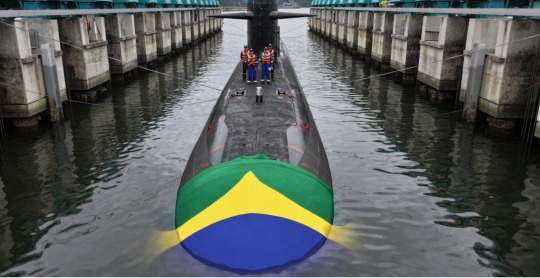
View On WordPress
0 notes
Text
Brazil sails mostly alone in push to modernize submarine fleet in South America
With little military threat on the immediate horizon, most South American countries continue to rely on decades-old subs. Brazil is an outlier.

Earlier this month the Brazilian Navy held a ceremony at the Itaguaí Naval Complex (ICN) in Rio de Janeiro for the first plate cutting to commence the construction of a nuclear-powered submarine — a historic step for the South American nation on a modernization journey it’s traveling mostly alone.
In partnership with France’s Naval Group, Brazil’s PROSUB program aims to construct a fleet of four Scorpene-class submarines and one nuclear-powered boat.
In September, the first Scorpene, dubbed Riachuelo (commissioned in 2022), made its much-heralded debut in the waters off the South American coast as part of the Tropicalex 2023 naval exercise.
Analysts told Breaking Defense that PROSUB is a unique submarine fleet modernization push among South American nations, most of whom still rely on decades-old subs – and see little reason to upgrade anytime soon.
Continue reading.
1 note
·
View note
Text

India agrees to acquire the 26 Rafale fighters and three Scorpene submarines from France 🇫🇷
Agreement should be signed today during the Bastille Day celebrations in France.
Fernando Valduga By Fernando Valduga 14/07/2023 - 08:51am Military
On Thursday, July 13, 2023, the Indian Ministry of Defense finally authorized the purchase of the 26 Rafale Marines and three long-awaited Scorpene submarines from France.
The choice of Rafale Marine follows a competition between the French aircraft and the U.S. F/A-18 Super Hornet fighter to equip the Indian Navy's STOBAR aircraft carriers.
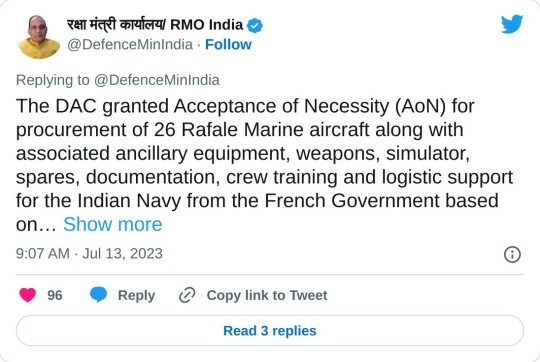
The announcement came the day before the national holiday of July 14 and its traditional military parade, of which Indian Prime Minister Narendra Modi is the guest of honor.

The Defense Acquisition Council of India approved the two acquisition proposals, the Indian Ministry of Defense said in a statement. The price, as well as other conditions, have not yet been negotiated with the French government.
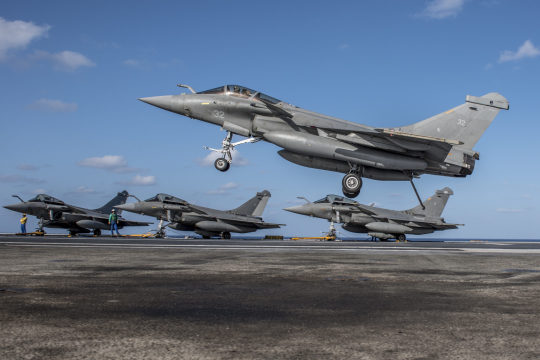
India is currently looking to replace the old MiG-29K in its naval air fleet, in accordance with the desire of the Indian government to increase the strength of its military forces. Located in the heart of the Indo-Pacific region, India has an extensive coastline, open to a maritime area through which much of international trade passes. The maritime and naval air power of New Delhi is a great challenge for Despite many differences, on human rights or the war in Ukraine, Western democracies are courting Narendra Modi because her country represents a counterweight to China in the region.
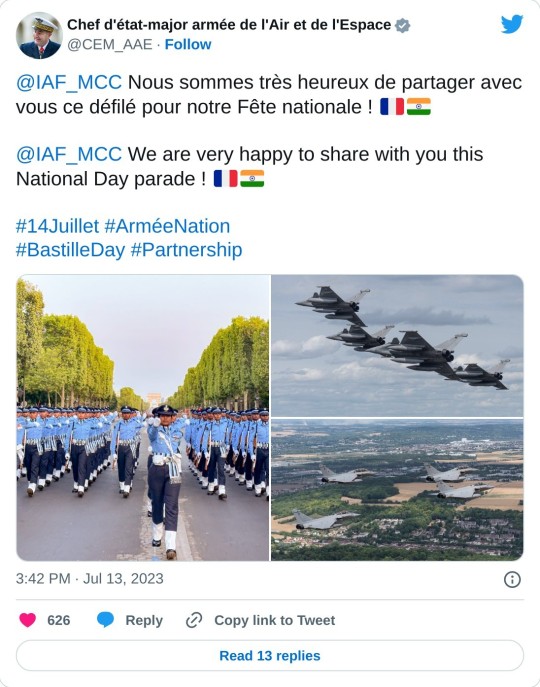
However, India wanted planes capable of taking off on its INS Vikrant aircraft carrier. Equipped with a STOBAR system - with hooked landing, but without a catapult to take off the planes - few planes were therefore compatible with the Indian aircraft carrier. Thus, a competition was held in December 2022 between the only two aircraft corresponding to the criteria defined by India: the North American F/A-18 Super Hornet and the French Rafale Marine.

The IAC1 Vikrant aircraft carrier.
Long awaited, the result of this competition has been the subject of much speculation. Observers or even internal sources of the Indian military authorities gave the winning Rafale and predicted the conclusion of an agreement between Paris and New Delhi, without any official confirmation of this agreement.
Discussions about these long-awaited agreements will take into account “all relevant aspects, including comparative prices for the acquisition of similar aircraft by other countries,” the statement said. As for submarines, India has already bought 6 of the Scorpene class from France.
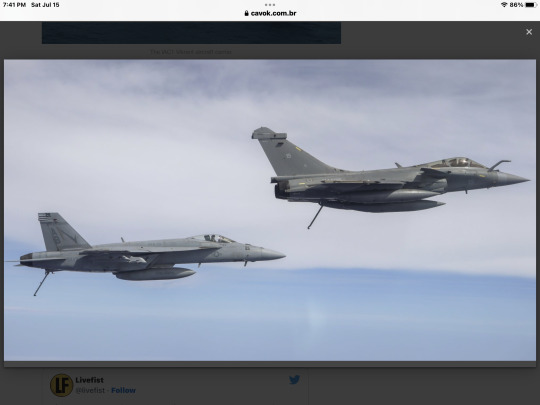
The press release from the Ministry of the Armed Forces of India specifies about the submarines that the three newcomers to the Indian fleet will be built "with greater indigenous content" by Mazagon Dock Shipbuilders, near Mumbai. This condition implies "significant employment opportunities in the national sector".
Previously, India had already announced a contract worth about 4.0 billion euros (at the time) for 36 Rafales in 2015. The first batch of five aircraft departed from France for India at the end of July 2020 to be included in Squadron No. 17 'Golden Arrows' at Ambala Air Force Station. The last aircraft of this order arrived in India in December 2022.

The naval variant was previously ordered by France, which ended up buying 42 and has been flying since 2002. This makes India the first exporting country of this variant.

A Rafale from the Indian Air Force.
France has thus won a new heavy contract for its successful fighter and strengthens its military-industrial ties with a country that it defines as one of the pillars of its strategy in the Indo-Pacific.
If it is really the last Rafale that India acquires, it remains to be seen. In October 2022, it became clear that India is looking for another 114 new 'multifunctional combat jets'. Several manufacturers from Europe, Russia and the United States are on the scene for this. India requires bidders to allow the domestic assembly of 96 of the 114 aircraft.
Tags: Military AviationDassault Rafale MIndian Navy
Sharing
tweet
Fernando Valduga
Fernando Valduga
Aviation photographer and pilot since 1992, has participated in several events and air operations, such as Cruzex, AirVenture, Daytona Airshow and FIDAE. He has works published in specialized aviation magazines in Brazil and abroad. Uses Canon equipment during his photographic work around the world of aviation.
Related news
MILITARY
New Zealand completes its fleet of P-8 Poseidon
15/07/2023 - 17:38
MILITARY
Decision of the next Swedish fighter is still several years away
15/07/2023 - 14:41
MILITARY
India confirms Rafale M's selection for the Indian Navy
15/07/2023 - 13:53
BRAZILIAN AIR FORCE
With F-5 monument, FAB War Hero is honored in Jataí (GO)
15/07/2023 - 10:02
MILITARY
Bombardier offers its maritime patrol aircraft option to replace the RCAF Orions
14/07/2023 - 21:22
HELICOPTERS
Czech Republic will supply more Mi-24/35 attack helicopters to Ukraine
14/07/2023 - 20:05
homeMain PageEditorialsINFORMATIONeventsCooperateSpecialitiesadvertiseabout
Cavok Brazil - Digital Tchê Web Creation
Commercial
Executive
Helicopters
HISTORY
Military
Brazilian Air Force
Space
Specialities
Cavok Brazil - Digital Tchê Web Creation
1 note
·
View note
Text
India will purchase Rafale Marine jets, Scorpene submarines from France
India will purchase Rafale Marine jets, Scorpene submarines from France
Rafale Marine for Indian Navy: In a major decision to boost its naval power, India Thursday approved procurement of 26 Rafale fighter jets manufactured by French defence company Dassault Aviation and procurement of 3 Scorpene class submarines that are being built in India under licence from French shipbuilder the Naval Group. The proposals were approved by the Defence Acquisition Council (DAC)…

View On WordPress
#France#India#India France Defence Deal#Narendra Modi#Naval Group#Rafale M for Indian Navy#Rafale Marine#Scorpene Submarines
0 notes
Text
pm modi: Defence ministry gives initial nod for 26 Rafale jets, 3 Scorpene submarines - The Economic Times
0 notes
Text
Defense deal of Ninety thousand crores...
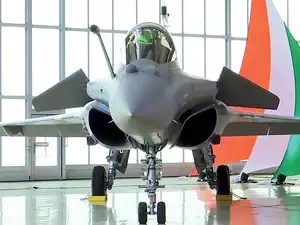
PM Modi Paris Visit: India's 90 thousand crore defense deal with France will further increase the power of the country to respond to China and Pakistan in their own language.

Raffale Fighter Jet. Image By- economictimes.indiatimes.com
PM Modi France Visit:-
Prime Minister Narendra Modi left for a three-day foreign trip on Thursday (July 13). PM Modi will stay in France on July 13 and 14 in the first phase of his foreign trip and PM will reach UAE in the second phase. This visit of PM Modi to France is considered very important for India. Actually, there is a possibility of a defense deal of 90 thousand crores between India and France on this tour. What will India get from this deal? Under this defense deal, India will get 26 Rafale fighter jets. Along with this, there will be an agreement to make 3 Scorpene class submarines in India. Significantly, the activities of India's neighboring country China in the Indo-Pacific region have increased considerably. In view of this, recently the Indian Navy had recommended the purchase of 26 Rafale maritime fighter aircraft for deployment on INS Vikrant. The power to answer Pakistan in their own language will increase further. In this defense deal, India is expected to get 22 single seat Rafale Marine fighter aircraft. These fighter aircraft will be stationed on INS Vikrant. At the same time, 4 trainer Rafale Marine aircraft will be available. Along with this, talk can also be made on the joint construction of 3 Scorpene submarines in India.
China-Pakistan will get a befitting reply:-
China-Pakistan will get a befitting reply Strategic and political relations between India and France are very deep. India and France are close allies with common interests in the Indo-Pacific region and the fight against terrorism. The close relations between the two countries can be gauged from the fact that France does not give any weapons to India's opponents. At the same time, India also refuses to share the stage with the opponents.
How old is France-India 'friendship' :-
How old is France-India 'friendship' Defense cooperation 70 years Space cooperation 58 years Strategic partnership 25 years Extradition treaty 18 years Nuclear energy cooperation 15 years Read the full article
#90thousandcroresdeal#china#crores.#defense#defensedealwithfrance#insvikrant#national#ninety#pakistan#PMModi#rafaledeal#Scorpeneclasssubmarines#thousand#trainerRafale
0 notes
Text
Germany's Bid for India's Submarine Project: A Potential Game Changer for Naval Power and Regional Stability
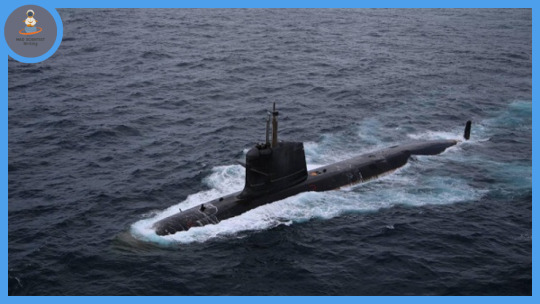
Hey, tumblr peeps! Have you heard about the latest development in India’s submarine project? It seems that Germany is pushing hard to win a $5.2 billion deal to build six stealth submarines for the Indian Navy under Project-75. This is a big deal because India has been relying heavily on Russian military hardware for decades, but now it’s looking for more options and partners in the wake of Russia’s war in Ukraine.
Germany’s Thyssenkrupp Marine Systems (TKMS) and India’s Mazagon Dock Shipbuilders Ltd (MDL) have signed a memorandum of understanding to jointly bid for the project, which involves building six advanced conventional submarines with better sensors, weapons and an air-independent propulsion (AIP) system that allows them to stay underwater longer. The German defense minister Boris Pistorius visited India this week and met with his Indian counterpart Rajnath Singh to discuss the deal and other strategic issues.
This is not the first time that Germany and India have collaborated on submarines. In the late 1980s, India sourced four submarines from Howaldtswerke-Deutsche Werft (HDW) of Germany, two of which were assembled at MDL in Mumbai. HDW has since been acquired by TKMS. However, the project ran into some delays and controversies due to allegations of corruption and technical glitches.
The current project has also faced some challenges due to certain specifications demanded by the Indian Navy, which were not acceptable to some of the submarine manufacturers. Initially, TKMS from Germany, Navantia from Spain, Daewoo of South Korea, Rosoboronexport/Rubin Design Bureau from Russia and France’s Naval Group were in the race. But the requirement of a proven AIP system ruled out the French and Spanish companies, while the Russians withdrew from the tender citing unrealistic expectations. The Koreans also showed little interest in the deal, leaving only the Germans in the fray.
However, even the Germans had some reservations about the contractual clauses and technical parameters. But with the intervention of the German government and the revision of its arms control laws, TKMS agreed to bid. The Indian Navy also approached the Ministry of Defense for relaxation of certain specifications and extension of the deadline for responding to the request for proposal (RFP).
The deal is not final yet, as there are still some negotiations and approvals required. The German defense minister said that there are also other competitors in the game, especially the French who have a strong presence in India’s naval sector. France’s Naval Group has already built six Scorpene-class submarines for the Indian Navy under Project-75 at MDL, the last of which was launched in November 2022.
India’s submarine fleet is aging and needs urgent modernization. The country currently operates 15 conventional submarines and two nuclear-powered submarines (one leased from Russia and one indigenously built). Most of these are due for decommissioning in the next decade. India also plans to build six nuclear-powered attack submarines (SSNs) and six nuclear-powered ballistic missile submarines (SSBNs) under its ambitious Advanced Technology Vessel (ATV) program.
India’s submarine project is part of its broader strategy to enhance its maritime capabilities and security in the Indian Ocean region, where it faces challenges from China and Pakistan. India has also been strengthening its naval partnerships with other countries like France, UAE, Japan, Australia and the US through joint exercises and agreements.
What do you think about this deal? Do you think Germany will be able to clinch it? How will it affect India’s naval power and regional stability? Share your thoughts in the comments below!
0 notes
Text

Indian Navy launches fourth Scorpene class submarine
In a major boost for the underwater capability of the Indian Navy, INS Vela, a Scorpene class submarine, is set to be rolled out today Navy officials said that Secretary (Defence Production) will launch the submarine for further trials at Mazagon Dockyards Limited (MDL) on today. It is to be noted that INS Vela is the fourth of the six Scorpene submarine that has completed its out fittings at MDL.
0 notes
Text
Daily Current affairs of 28th Jan 2023

Practice daily Current affairs and give quiz for assess your knowledge. Today you can study current affairs of 28th Jan 2023 and this is suitable for almost all type of government competitive exams.
Daily Current affairs for 27th Jan 2023
Q1. What is the name of the fifth stealth Scorpene class Submarine, which was recently commissioned into the Indian Navy? A. INS Vagir B. INS Virat C. INS Vaaman D. INS Vajra Answer INS Vagir Q2. Which institution launched an information database including a repository of information pertaining to municipal bonds? A. RBI B. SEBI C. IRDAI D. NSE Answer SEBI Q3. World Bank has appreciated which country for its transition from poorest to one of the fastest growing countries? A. India B. Indonesia C. Bangladesh D. Nepal Answer Bangladesh Q4. As per the Finance Ministry data, the Atal Pension Yojana (APY) subscribers figure crossed which milestone in 2022? A. 1 million B. 10 million C. 5 million D. 50 million Answer 10 million Q5. Which state announced to book men who marry minor girls under stringent laws prescribing imprisonment? A. West Bengal B. Assam C. Telangana D. Odisha Answer Assam Q6. Which country announced the introduction of the Debbie Hockley Medal to honour the outstanding female cricketer? A. England B. New Zealand C. West Indies D. Australia Answer New Zealand Q7. Who has become the first Asian to bag an Oscar nomination for Best Actress, in January 2023? A. Ke Huy Quan B. Kerry Washington C. Michelle Yeoh D. Gong Li Answer Michelle Yeoh Q8. On 26 January 2023, how many personnel have been awarded the President's Fire Service Medals for distinguished service? A. 39 B. 43 C. 47 D. 51 Answer 47 Q9. Yoshio James Yoda passed away on 23 January 2023. He was a famous _______. A. Doctor B. Lawyer C. Actor D. Footballer Answer Actor Q10. Who has been elected as the President of the Indian Paper Manufactures Association (IPMA) at the 23rd Annual Session of IPMA in January 2023? A. Pawan Agarwal B. Ajay Kumar Srivastava C. Sujoy Lal Thaosen D. Ajit Kumar Saxena Answer Pawan Agarwal Now Try Quiz of Jan Current Affairs 2023 Attention: You must prepare daily current affairs of January 2023 for Quiz, so you can rank better and motivate for your upcoming government exam comptition.
Also practice other's day current affairs of Jan 2023
- Current affairs of 1st Jan 2023 - Current affairs of 2nd Jan 2023 - Current affairs of 3rd Jan 2023 - Current affairs of 4th Jan 2023 - Current affairs of 5th Jan 2023 - Current affairs of 6th Jan 2023 - Current affairs of 7th Jan 2023 - Current affairs of 8th Jan 2023 - Current affairs of 9th Jan 2023 - Current affairs of 10th Jan 2023 - Current affairs of 11th Jan 2023 - Current affairs of 12th Jan 2023 - Current affairs of 13th Jan 2023 - Current affairs of 14th Jan 2023 - Current affairs of 15th Jan 2023 - Current affairs of 16th Jan 2023 - Current affairs of 17th Jan 2023 - Current affairs of 18th Jan 2023 - Current affairs of 19th Jan 2023 - Current affairs of 20th Jan 2023 - Current affairs of 21st Jan 2023 - Current affairs of 22nd Jan 2023 - Current affairs of 23rd Jan 2023 - Current affairs of 24th Jan 2023 - Current affairs of 25th Jan 2023 - Current affairs of 26th Jan 2023 - Current affairs of 27th Jan 2023 - Current affairs of 28th Jan 2023 - Current affairs of 29th Jan 2023 - Current affairs of 30th Jan 2023 - Current affairs of 31st Jan 2023
Video Current Affairs MCQs of 25th Jan 2023
Read the full article
0 notes
Text
Arihant-Class Submarines: India's Maritime Security Vanguard
Maritime Security and Submarines of India: The Arihant Class

India, with its extensive coastline of over 7,500 kilometers, has a profound strategic interest in ensuring robust maritime security. The Indian Ocean, a crucial artery for global trade, is witnessing increasing geopolitical competition. Ensuring the safety and security of these waters is paramount for India, not only for national defense but also for economic stability. One of the critical components of India's maritime strategy is its submarine fleet, particularly the Arihant class, which plays a pivotal role in the nation's naval force.
The Importance of Maritime Security
Maritime security encompasses a wide array of concerns, including the protection of sea lines of communication (SLOCs), prevention of maritime terrorism, anti-piracy operations, and the safeguarding of offshore resources. For India, the Indian Ocean is not just a route for its international trade but also a strategic theater where it must counter various threats, ranging from piracy to the increasing naval presence of other powers like China.
India's strategic interests in the region are further complicated by its need to secure its Exclusive Economic Zone (EEZ), which spans over 2 million square kilometers, and its rich undersea resources. The Indian Navy, therefore, plays a crucial role in maintaining a balance of power in the region and ensuring a free and open maritime domain.
Evolution of India's Submarine Fleet
India's submarine fleet has evolved significantly since it commissioned its first Submarines of India, INS Kalvari, in 1967. The Indian Navy's submarine force consists of both conventional diesel-electric submarines and nuclear-powered submarines. Over the years, India has aimed to develop a credible underwater combat force capable of both defensive and offensive operations.
The acquisition and development of submarines have been guided by India's need to deter regional adversaries and project power within the Indian Ocean Region (IOR). The Indian Navy's submarine force includes the Kilo-class (Sindhughosh-class), HDW Type 209/1500 (Shishumar-class), Scorpene-class (Kalvari-class), and the indigenous Arihant-class nuclear-powered submarines.
The Arihant Class: India’s Nuclear Deterrent
The Arihant-class submarines represent a significant leap in India's naval capabilities. These submarines are the first nuclear-powered ballistic missile submarines (SSBNs) built by India, marking a critical component of India's strategic nuclear deterrent. The Arihant class is designed to provide India with a credible second-strike capability, ensuring that India can retaliate in the event of a nuclear attack, thereby maintaining a stable deterrence posture.
Development and Commissioning:
The development of the Arihant class began under the Advanced Technology Vessel (ATV) project, which was initiated in the 1980s. The project was shrouded in secrecy, with significant assistance from Russia in the form of technology transfer and technical expertise. INS Arihant, the lead vessel of the class, was launched in 2009 and commissioned into the Indian Navy in 2016.
Design and Capabilities:
The Arihant-class submarines are based on the Russian Akula-1 class design but have been modified to meet Indian requirements. These submarines are powered by an 83 MW pressurized water reactor, allowing them to remain submerged for extended periods, which is crucial for their role as a stealthy deterrent platform.
The submarines are equipped with K-15 Sagarika missiles, which have a range of about 750 kilometers, and the K-4 ballistic missiles, with a range of 3,500 kilometers. This enables the Arihant-class submarines to target adversaries well beyond India's borders, enhancing the strategic reach of the Indian Navy.
Operational Significance:
The primary role of the Arihant class is to provide a secure and survivable second-strike capability. In the event of a nuclear conflict, these submarines are designed to remain undetected in the vast expanse of the ocean, ready to launch a retaliatory strike if necessary. This capability is central to India's nuclear doctrine of "No First Use" and ensures that India can maintain a credible deterrent against its nuclear-armed neighbors.
The Strategic Role of the Indian Navy
The Indian Navy's strategic objectives are guided by the need to protect India's maritime interests and assert its influence in the Indian Ocean Region. The induction of the Arihant-class submarines is a testament to India's commitment to strengthening its naval capabilities and enhancing its strategic deterrence.
Power Projection:
With the Arihant-class submarines, India can project power far beyond its immediate neighborhood. The ability to launch nuclear missiles from the sea gives India a strategic advantage, allowing it to deter potential adversaries from undertaking aggressive actions. This power projection is not only a means of deterrence but also a way to establish India's role as a major player in regional and global security.
Maritime Diplomacy:
The presence of a strong and capable submarine force also plays a role in India's maritime diplomacy. By demonstrating its advanced capabilities, India can engage with other maritime nations on a more equal footing, fostering cooperation in areas such as counter-piracy, maritime domain awareness, and joint naval exercises. This helps to build alliances and partnerships that are essential for maintaining stability in the Indian Ocean Region.
Countering Regional Threats:
India faces several maritime threats, including the growing presence of the Chinese Navy in the Indian Ocean. The development of the Arihant-class submarines is a direct response to these challenges, providing India with a credible means to counterbalance the influence of other regional powers. The ability to operate stealthily and deliver powerful strikes ensures that India can protect its interests and maintain a strategic edge.
Future Prospects and Challenges
While the Arihant-class submarines mark a significant milestone, India continues to face challenges in further enhancing its submarine capabilities. The Indian Navy has plans to expand its SSBN fleet with the construction of additional Arihant-class submarines and the development of new, more advanced models.
Technological Advancements:
Future submarines are expected to feature advancements in stealth technology, longer-range missiles, and improved sensors and communication systems. These enhancements will be crucial in maintaining the effectiveness and survivability of India's underwater fleet in an increasingly contested maritime environment.
Industrial and Technological Hurdles:
Despite the progress made, India still faces hurdles in terms of indigenous development and production capabilities. Ensuring self-reliance in critical technologies and reducing dependence on foreign suppliers remain significant challenges. Addressing these issues will require sustained investment in research and development, as well as collaboration with international partners.
Strategic Imperatives:
As India continues to enhance its submarine capabilities, it must also focus on the broader strategic imperatives of maritime security. This includes strengthening its conventional naval forces, improving maritime domain awareness through enhanced surveillance and intelligence capabilities, and fostering regional cooperation to address shared security challenges.
Conclusion

The Arihant-class submarines represent a significant advancement in India's maritime security and strategic deterrence capabilities. As the cornerstone of India's underwater nuclear deterrent, these submarines enhance the Indian Navy's ability to protect the nation's maritime interests and project power in the Indian Ocean Region. The continued development and expansion of India's submarine fleet will be crucial in addressing the evolving security dynamics and maintaining stability in the region. As India navigates these challenges, the Arihant class stands as a testament to its commitment to achieving a credible and robust maritime defense posture.
1 note
·
View note
Text
COMMISSIONING OF FIFTH KALVARI CLASS SUBMARINE ‘VAGIR’ HELD
Mumbai: Indian Navy’s fifth stealth Scorpene class Submarine INS Vagir was commissioned into the Indian Navy on Monday at the Naval Dockyard Mumbai in the presence of Adm R Hari Kumar, Chief of the Naval Staff. Six Scorpene Class submarines are being built in India by the Mazagon Dock Shipbuilders Limited (MDL) Mumbai, under collaboration with M/s Naval Group, France. INS Vagir would form part…
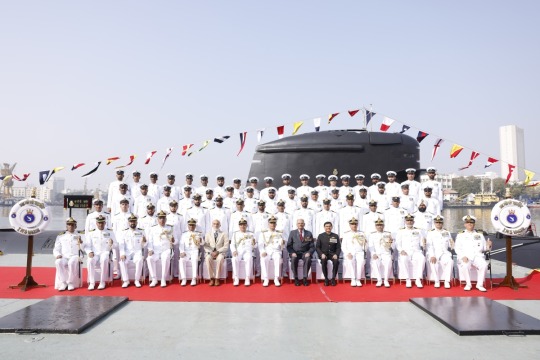
View On WordPress
1 note
·
View note